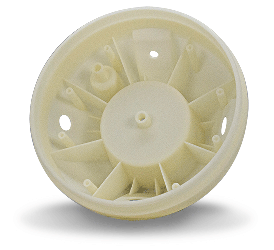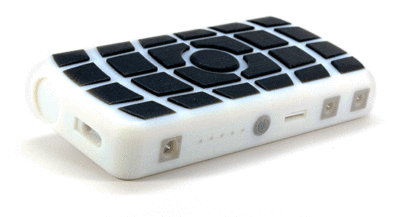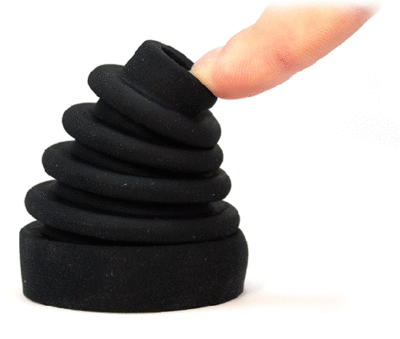3D Printing Materials
We offer a large variety of 3D printing materials across a number of technologies. It can be difficult to know which material is right for your application. Below we have all of our materials listed together and broken down by technology and application.
You can sort these tables by their column headings to find the right material for the job.
All 3D Printing Materials
Every material we offer at 3 Space is listed in the table below along with which 3D printing technology they belong to and their relevant technical specifications. Click the column labels to sort by whichever specification is most important for your project or to sort by technology.
| Technology | Tensile Strength | Tensile Modulus | Tensile Elongation | Flexural Strength | Flexural Modulus | Notched Impact | Shore Hardness | HDT @ 66 psi | HDT @ 264 psi | Glass Transition | |
|---|---|---|---|---|---|---|---|---|---|---|---|
| ABS-ESD7 | FDM | 5,200 psi | 350,000 psi | 5% | 8,800 psi | 336.000 psi | 2.6 ft-lb/in | 78 Scale D | 204 °F | 122 °F | 126 °F |
| ABS-M30 | FDM | 5,200 psi | 350,000 psi | 3% | 8,800 psi | 350.000 psi | 2.1 ft-lb/in | R 109.5 | 204 °F | 122 °F | 126 °F |
| Nylon 12 | FDM | 7,000 psi | 190,000 psi | 30% | 10,000 psi | 190.000 psi | 2.8 ft-lb/in | 207 °F | |||
| PC-ABS | FDM | 5,900 psi | 278,000 psi | 6% | 9,800 psi | 280.000 psi | 3.7 ft-lb/in | R 110 | 230 °F | 205 °F | 257 °F |
| Polycarbonate | FDM | 9,800 psi | 330,000 psi | 5% | 15,100 psi | 324.000 psi | 1 ft-lb/in | R 115 | 280 °F | 261 °F | 322 °F |
| PPSF | FDM | 8,000 psi | 300,000 psi | 3% | 15,900 psi | 320.000 psi | 1.1 ft-lb/in | M86 | 372 °F | 446 °F | |
| Ultem 9085 | FDM | 10,400 psi | 322,000 psi | 6% | 16,700 psi | 362.000 psi | 2.0 ft-lb/in | 307 °F | 367 °F | ||
| PolyJet ABS | PolyJet | 8,700 psi | 435,000 psi | 40% | 11,000 psi | 320.000 psi | 1.5 ft-lb/in | 87 Scale D | 194 °F | 131 °F | 127 °F |
| RDG525 | PolyJet | 11,500 psi | 510,000 psi | 15% | 19,000 psi | 510.000 psi | 0.30 ft-lb/in | 88 Scale D | 163 °F | 176 °F | 149 °F |
| RGD720 | PolyJet | 9,450 psi | 435,000 psi | 25% | 16,000 psi | 480.000 psi | 0.56 ft-lb/in | 86 Scale D | 122 °F | 122 °F | 122 °F |
| Rigur | PolyJet | 6,500 psi | 305,000 psi | 35% | 8,500 psi | 246.000 psi | 0.66 ft-lb/in | 84 Scale D | 129 °F | 122 °F | 126 °F |
| Tango | PolyJet | 220 psi | 220% | 28 Scale A | |||||||
| Vero | PolyJet | 9,450 psi | 435,000 psi | 25% | 16,000 psi | 465.000 psi | 0.56 ft-lb/in | 86 Scale D | 122 °F | 122 °F | 129 °F |
| SC 1000 | SLA | 7,758 psi | 387,000 psi | 8% | 12,010 psi | 280.000 psi | 0.35 ft-lb/in | 83 Scale D | 127 °F | 122 °F | |
| Somos NeXt | SLA | 6,100 psi | 352,000 psi | 9% | 10,100 psi | 358.000 psi | 0.94 ft-lb/in | 82 Scale D | 133 °F | 122 °F | |
| Somos Protogen | SLA | 6,200 psi | 326,000 psi | 12% | 299.000 psi | 0.39 ft-lb/in | 87 Scale D | 205 °F | |||
| WaterClear Ultra | SLA | 8,100 psi | 418,000 psi | 8% | 12,200 psi | 361.000 psi | 0.47 ft-lb/in | 87 Scale D | 140 °F | 122 °F | |
| WaterShed SC | SLA | 7,300 psi | 402,000 psi | 16% | 10,000 psi | 320.000 psi | 0.47 ft-lb/in | 122 °F | 120 °F | ||
| Flex TPE | SLS | 262 psi | 800,000 psi | 5% | 860 psi | 40 Scale A | |||||
| Nylon 12 AF | SLS | 4,628 psi | 373,800 psi | 1% | 7,832 psi | 289.250 psi | 0.8 ft-lb/in | 351 °F | 279 °F | ||
| Nlon 12 GF | SLS | 5,200 psi | 420,000 psi | 1% | 8,800 psi | 325.000 psi | 0.8 ft-lb/in | 354 °F | 273 °F | ||
| Nylon 12 HST | SLS | 7,050 psi | 800,000 psi | 5% | 12,000 psi | 640,000 psi | 0.7 ft-lb/in | 363 °F | 355 °F | ||
| Nylon 12 PA | SLS | 6,815 psi | 246,500 psi | 15% | 6,850 psi | 188.549 psi | 0.8 ft-lb/in | 350 °F | 187 °F |
3D Printing Materials by Technology
In the tables below, we’ve sorted our materials by 3D printing technology. If you already know which technology is right for you, you can use these tables to find the right material using their specifications.
FDM
PolyJet
SLA
SLS
FDM
| Tensile Strength | Tensile Modulus | Tensile Elongation | Flexural Strength | Flexural Modulus | Notched Impact | Shore Hardness | HDT @ 66 psi | HDT @ 264 psi | Glass Transition | |
|---|---|---|---|---|---|---|---|---|---|---|
| ABS-ESD7 | 5,200 psi | 350,000 psi | 5% | 8,800 psi | 336.000 psi | 2.6 ft-lb/in | 78 Scale D | 204 °F | 122 °F | 126 °F |
| ABS-M30 | 5,200 psi | 350,000 psi | 3% | 8,800 psi | 350.000 psi | 2.1 ft-lb/in | R 109.5 | 204 °F | 122 °F | 126 °F |
| Nylon 12 | 7,000 psi | 190,000 psi | 30% | 10,000 psi | 190.000 psi | 2.8 ft-lb/in | 207 °F | |||
| PC-ABS | 5,900 psi | 278,000 psi | 6% | 9,800 psi | 280.000 psi | 3.7 ft-lb/in | R 110 | 230 °F | 205 °F | 257 °F |
| Polycarbonate | 9,800 psi | 330,000 psi | 5% | 15,100 psi | 324.000 psi | 1 ft-lb/in | R 115 | 280 °F | 261 °F | 322 °F |
| PPSF | 8,000 psi | 300,000 psi | 3% | 15,900 psi | 320.000 psi | 1.1 ft-lb/in | M86 | 372 °F | 446 °F | |
| Ultem 9085 | 10,400 psi | 322,000 psi | 6% | 16,700 psi | 362.000 psi | 2.0 ft-lb/in | 307 °F | 367 °F |
PolyJet
| Tensile Strength | Tensile Modulus | Tensile Elongation | Flexural Strength | Flexural Modulus | Notched Impact | Shore Hardness | HDT @ 66 psi | HDT @ 264 psi | Glass Transition | |
|---|---|---|---|---|---|---|---|---|---|---|
| PolyJet ABS | 8,700 psi | 435,000 psi | 40% | 11,000 psi | 320.000 psi | 1.5 ft-lb/in | 87 Scale D | 194 °F | 131 °F | 127 °F |
| RDG525 | 11,500 psi | 510,000 psi | 15% | 19,000 psi | 510.000 psi | 0.30 ft-lb/in | 88 Scale D | 163 °F | 176 °F | 149 °F |
| RGD720 | 9,450 psi | 435,000 psi | 25% | 16,000 psi | 480.000 psi | 0.56 ft-lb/in | 86 Scale D | 122 °F | 122 °F | 122 °F |
| Rigur | 6,500 psi | 305,000 psi | 35% | 8,500 psi | 246.000 psi | 0.66 ft-lb/in | 84 Scale D | 129 °F | 122 °F | 126 °F |
| Tango | 220 psi | 220% | 28 Scale A | |||||||
| Vero | 9,450 psi | 435,000 psi | 25% | 16,000 psi | 465.000 psi | 0.56 ft-lb/in | 86 Scale D | 122 °F | 122 °F | 129 °F |
SLA
| Tensile Strength | Tensile Modulus | Tensile Elongation | Flexural Strength | Flexural Modulus | Notched Impact | Shore Hardness | HDT @ 66 psi | HDT @ 264 psi | Glass Transition | |
|---|---|---|---|---|---|---|---|---|---|---|
| SC 1000 | 7,758 psi | 387,000 psi | 8% | 12,010 psi | 280.000 psi | 0.35 ft-lb/in | 83 Scale D | 127 °F | 122 °F | |
| Somos NeXt | 6,100 psi | 352,000 psi | 9% | 10,100 psi | 358.000 psi | 0.94 ft-lb/in | 82 Scale D | 133 °F | 122 °F | |
| Somos Protogen | 6,200 psi | 326,000 psi | 12% | 299.000 psi | 0.39 ft-lb/in | 87 Scale D | 205 °F | |||
| WaterClear Ultra | 8,100 psi | 418,000 psi | 8% | 12,200 psi | 361.000 psi | 0.47 ft-lb/in | 87 Scale D | 140 °F | 122 °F | |
| WaterShed SC | 7,300 psi | 402,000 psi | 16% | 10,000 psi | 320.000 psi | 0.47 ft-lb/in | 122 °F | 120 °F |
SLS
| Tensile Strength | Tensile Modulus | Tensile Elongation | Flexural Strength | Flexural Modulus | Notched Impact | Shore Hardness | HDT @ 66 psi | HDT @ 264 psi | Glass Transition | |
|---|---|---|---|---|---|---|---|---|---|---|
| Flex TPE | 262 psi | 800,000 psi | 5% | 860 psi | 40 Scale A | |||||
| Nylon 12 AF | 4,628 psi | 373,800 psi | 1% | 7,832 psi | 289.250 psi | 0.8 ft-lb/in | 351 °F | 279 °F | ||
| Nlon 12 GF | 5,200 psi | 420,000 psi | 1% | 8,800 psi | 325.000 psi | 0.8 ft-lb/in | 354 °F | 273 °F | ||
| Nylon 12 HST | 7,050 psi | 800,000 psi | 5% | 12,000 psi | 640,000 psi | 0.7 ft-lb/in | 363 °F | 355 °F | ||
| Nylon 12 PA | 6,815 psi | 246,500 psi | 15% | 6,850 psi | 188.549 psi | 0.8 ft-lb/in | 350 °F | 187 °F |
3D Printing Materials by Application
In this table, we’ve rated each of our materials by their suitability to particular applications. Because every project is unique in its requirements, these values may not be universally accurate. But this table will help as a general guide for which materials are right for which application.
| Technology | Cosmetic Prototypes | Fit Testing | Functional Parts | Jigs & Fixtures | High Temp | Flexible Parts | |
|---|---|---|---|---|---|---|---|
| ABS-ESD7 | FDM | ★★★★ | ★★★★ | ★★★★★ | ★★★★★ | ★★★ | ★ |
| ABS-M30 | FDM | ★★★★ | ★★★★ | ★★★★★ | ★★★★★ | ★★★ | ★ |
| Nylon 12 | FDM | ★★ | ★★ | ★★★★★ | ★★★★ | ★★★ | ★★★ |
| PC-ABS | FDM | ★★★★ | ★★★★ | ★★★★★ | ★★★★★ | ★★★★ | ★ |
| Polycarbonate | FDM | ★★★★ | ★★★★ | ★★★★★ | ★★★★★ | ★★★★ | ★ |
| PPSF | FDM | ★★ | ★★ | ★★★★★ | ★★★★★ | ★★★★★ | ★ |
| Ultem 9085 | FDM | ★★ | ★★ | ★★★★★ | ★★★★★ | ★★★★ | ★★ |
| PolyJet ABS | PolyJet | ★★★★★ | ★★★★★ | ★★★ | ★★★ | ★★ | ★★★ |
| RDG525 | PolyJet | ★★★★★ | ★★★★★ | ★★★ | ★★★ | ★★★ | ★★ |
| RGD720 | PolyJet | ★★★★★ | ★★★★★ | ★★ | ★★ | ★ | ★★ |
| Rigur | PolyJet | ★★★★★ | ★★★★★ | ★★★ | ★★★ | ★★ | ★★ |
| Tango | PolyJet | ★★★★ | ★★★★ | ★★ | ★ | ★ | ★★★★★ |
| Vero | PolyJet | ★★★★★ | ★★★★ | ★ | ★ | ★ | ★ |
| SC 1000 | SLA | ★★★★★ | ★★★ | ★★ | ★★ | ★ | ★ |
| Somos NeXt | SLA | ★★★★ | ★★★★ | ★★★ | ★★ | ★ | ★ |
| Somos Protogen | SLA | ★★★★ | ★★★★ | ★★★ | ★★ | ★★ | ★ |
| WaterClear Ultra | SLA | ★★★★ | ★★★★ | ★★★ | ★★★ | ★ | ★ |
| WaterShed SC | SLA | ★★★★ | ★★★★ | ★★★ | ★★★ | ★ | ★ |
| Flex TPE | SLS | ★★★ | ★★★ | ★★★ | ★★ | ★★★ | ★★★★★ |
| Nylon 12 AF | SLS | ★★★ | ★★★ | ★★★★ | ★★★★ | ★★★★ | ★★ |
| Nlon 12 GF | SLS | ★★★ | ★★★ | ★★★★ | ★★★★ | ★★★★ | ★★ |
| Nylon 12 HST | SLS | ★★★ | ★★★ | ★★★★★ | ★★★★★ | ★★★★★ | ★★★ |
| Nylon 12 PA | SLS | ★★★ | ★★★ | ★★★★ | ★★★★ | ★★★★ | ★★★ |

 Extruded thermoplastics are what typically come to mind when someone thinks of 3D printing. Their rigidity and durability have contributed to their wide use in a variety of industries, making them the most common 3D printing materials available. Depending on the specific thermoplastic, there are additional mechanical properties that make them desirable for every day use, including heat resistance, fatigue resistance, high tensile strength, high flexural strength, low weight, electrical-dissipation, and more. Some can even simulate the appearance and feel of rubber. Common 3D printing thermoplastics include ABS-M30, ABS-ESD7, PC-ABS, Polycarbonate, PPSF, ULTEM 9085, Nylon 12, and TPU.
Extruded thermoplastics are what typically come to mind when someone thinks of 3D printing. Their rigidity and durability have contributed to their wide use in a variety of industries, making them the most common 3D printing materials available. Depending on the specific thermoplastic, there are additional mechanical properties that make them desirable for every day use, including heat resistance, fatigue resistance, high tensile strength, high flexural strength, low weight, electrical-dissipation, and more. Some can even simulate the appearance and feel of rubber. Common 3D printing thermoplastics include ABS-M30, ABS-ESD7, PC-ABS, Polycarbonate, PPSF, ULTEM 9085, Nylon 12, and TPU.  Photopolymers may be 3D printed with three different technologies: PolyJet, MultiJet, and Stereolithography (SLA).
Photopolymers may be 3D printed with three different technologies: PolyJet, MultiJet, and Stereolithography (SLA).  Best Applications
Best Applications
 Although metal is most commonly machined, it can also be 3D printed. While metals are the strongest 3D printing material, they are also the most expensive, which is why plastic is the preferred material type for most 3D printed parts. 3D printing metals come in a powdered form just as the materials for SLS. The metals retain the same mechanical properties as if they were machined, including high strength, heat resistance, corrosion resistance, weldability, and ductility. Some 3D printing metals are biocompatible, which enables them to be used in the dental and medical fields in addition to the oil, gas, and automotive industries. Common 3D printed metals include Stainless Steel 17-4 PH, Stainless Steel 316L, Aluminum AlSi10Mg, INCONEL 625, INCONEL 718, Titanium Ti64, Cobalt Chrome CoCrMo, MONEL K500, and Copper C18150.
Although metal is most commonly machined, it can also be 3D printed. While metals are the strongest 3D printing material, they are also the most expensive, which is why plastic is the preferred material type for most 3D printed parts. 3D printing metals come in a powdered form just as the materials for SLS. The metals retain the same mechanical properties as if they were machined, including high strength, heat resistance, corrosion resistance, weldability, and ductility. Some 3D printing metals are biocompatible, which enables them to be used in the dental and medical fields in addition to the oil, gas, and automotive industries. Common 3D printed metals include Stainless Steel 17-4 PH, Stainless Steel 316L, Aluminum AlSi10Mg, INCONEL 625, INCONEL 718, Titanium Ti64, Cobalt Chrome CoCrMo, MONEL K500, and Copper C18150.